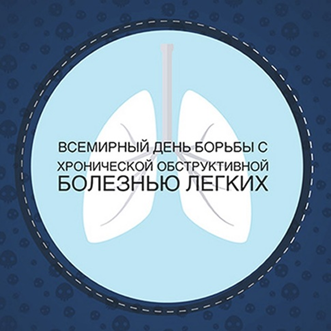
Chronic obstructive pulmonary disease (COPD) is a common disease of the respiratory system. It is a chronic, inflammatory process that leads to changes in the bronchial wall, causing restriction of airflow and making it difficult to breathe.
Symptoms of COPD are nonspecific and at the initial stages of the disease are almost not clearly manifested, which leads to late diagnosis and irreversible changes in the bronchial wall, impaired bronchial and lung function. In the bronchi is produced in large quantities of mucus, increases its viscosity, which is favorable for the growth of bacteria and destroys the bronchial wall. This disrupts patency in the bronchi and formed pulmonary emphysema, pneumosclerosis, respiratory failure progresses.
COPD, second to ischemic heart disease and acute cerebral circulatory disorders, is among the three leading causes of mortality.
Key facts according to WHO data:
- COPD ranks fourth among the leading causes of death in the world, with 3.5 million deaths registered in 2021 - approximately 5% of all deaths in the world.
- Almost 90% of COPD deaths among people under 70 years of age occur in low- and middle-income countries.
- COPD ranks eighth among the causes of morbidity in the world.
- Smoking is an important factor in the development of COPD and increases mortality in 60% of women and 80% of men in developed countries. In developing countries, these figures are lower - 20 and 45%, respectively, as bad ecology, passive smoking and occupational hazards take the first place.
The main symptoms of COPD are cough with sputum and shortness of breath.
At the beginning of the disease, coughing is rare, the amount of sputum is small, dyspnea occurs only with intense physical activity, and in its severe course, coughing is constant, dyspnea is noted at rest, there are signs of cardiovascular insufficiency (edema in the legs; heaviness in the right subcostal area). With the accession of secondary infection, sputum becomes purulent, cough significantly increases, and there are distant wheezing and signs of intoxication.
COPD risk factors:
- active and passive smoking
- genetic predisposition
- occupational hazards (miners, construction workers, workers in contact with cement, metal processing, etc.).
- low socioeconomic status
- Male sex more often than female sex
- age - from 35 years
- low weight
The risk of the disease is higher if there is a genetic predisposition, smoking, frequent bronchitis, acute respiratory viral infections and other lung diseases.
Prevention of COPD:
- observance of a healthy lifestyle (smoking cessation, physical activity)
- minimizing the impact on the bronchopulmonary system of substances that can provoke the development of the disease
- vaccination against pneumococcal and viral infections
- timely treatment of bronchopulmonary infections
Important!
In an exacerbation, to reduce the activity of the inflammatory process and maintain the achieved remission for a longer period, will help to comply with all therapeutic and preventive measures recommended by the doctor.
During remission, the patient shall have physiotherapy and sanatorium-resort treatment.



